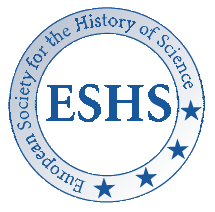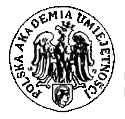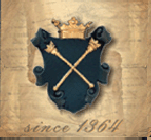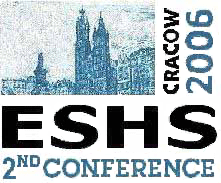Last modification: 24 September 2008
Online Book of Abstracts - A Thematic List:
SESSIONS / SYMPOSIA
Edited by Michal Kokowski
http://www.cyfronet.pl/~n1kokows/home.html
n1kokows@cyf-kr.edu.pl
Symposium R-3.
HISTORY OF ASTRONOMY IN THE LATE MEDIEVAL
AND EARLY MODERN PERIODS
ORGANIZERS AND CHAIRMEN OF THE SYMPOSIUM:
José CHABÁS (Barcelona, Spain)
jose.chabas@upf.edu
Richard L. KREMER (Hanover, NH, USA)
Richard.L.Kremer@Dartmouth.EDU
R-3.
From Toledo to Venice: The Alfonsine Tables of Prosdocimo de' Beldomandi
José CHABÁS (Barcelona, Spain)
jose.chabas@upf.edu
The Alfonsine Tables were compiled in Toledo by Isaac ben Sid and Judah ben Moses ha-Cohen, two of the most active collaborators of Alfonso X, king of Castille and León (reigned: 1252-1284). The original version of these tables is not extant, but the canons explaining their use have survived in a unique manuscript in Castilian. From Toledo the tables reached Paris and were recast there in the 1320s, then spread throughout Europe, and became the main computing tool used by astronomers for more than two centuries. In 1483 the Parisian Alfonsine Tables were published in Venice for the first time, followed shortly thereafter by other editions, all of them by printers in that city.
During the period of more than two centuries between their compilation and their first publication, the Alfonsine Tables made a long journey and were subject to many changes, without losing the basic features that characterized them. We still lack a global picture of the transmission of all tabular material associated with the Alfonsine Tables. In order to help fill in this essential gap in the history of astronomy in late Middle Ages and early modern times, we analyse here the version of the Alfonsine Tables compiled by Prosdocimo de' Beldomandi, an astronomer in Padua who died in 1428, focusing our attention on his catalogue of more than 1,000 stars which is closely related to the star catalogues published in the incunabula editions.
R-3.
Reflection of Iohannes Sindel's Eclipse Instrument in Iohannes Schöner's "Opera mathematica"
Alena HADRAVOVÁ (Prague, The Czech Republik)
had@pleione.asu.cas.cz
Petr HADRAVA (Prague, The Czech Republik)
had@pleione.asu.cas.cz
Master of the Prague University Iohannes Andreae dictus Schindel (John Andrew's called Sindel, 1375-1455/1457) is known as an astronomical advisor of the construction of Prague Astronomical Clock (1410). He is also known as author of several astronomical treatises. One of the most important is his text "Canones pro eclipsibus Solis et Lune per instrumentum ad hoc factum inveniendis Magistri Iohannis Schindel" ("The rules for a calculation of Sun's and Moon's eclipses using the instrument invented by John Sindel") which describes Sindel's instrument derived from the albion by Richard of Wallingford (c. 1292-1335). Albion was also dealt with by Sindel's Vienna colleague Iohannes von Gmunden (1380-1442). The description of Sindel's instrument appears also in Iohannes Schöner's (1477-1547) book "Opera mathematica" (Nürnberg 1551, 1561), this is more than a century after Sindel.
Several passages of Schöner's text are verbally identical with Schindel's treatise. Moreover, "Opera mathematica" involves woodcuts of the instrument which correspond exactly with Schindel's explanation. The only three preserved manuscripts with Sindel's treatise, which we prepare for publication, lack any drawing. Schöner's evidence of the eclipse instrument design is thus valuable for better understanding of Sindel's words.
R-3.
Astronomy in Paulerinus's 15th Century Encyclopaedia "Liber viginti arcium"
Alena HADRAVOVÁ (Prague, The Czech Republik)
had@pleione.asu.cas.cz
Petr HADRAVA (Prague, The Czech Republik)
had@pleione.asu.cas.cz
In the middle of the 15th century master of five universities (Prague, Cracow, Vienna, Padova, Bologna) Paulerinus (Pavel Zidek, 1413-1471) composed his extensive encyclopaedia "Liber viginti arcium" ("The Book of Twenty Arts") for the Czech king George of Podebrady. It is preserved in unique parchment manuscript, located in the Jagellonian Library in Cracow under the signature BJ 257, which contains nearly 400 very spacious folios. The text on folios 131ra-142vb deals with astronomy, folios 143r-152v include astronomical tables. Astronomical and astrological contexts appear also in several others parts of encyclopaedia, e.g. those dealing with meteorology, medicine etc. The part of astronomy is very extensive, it treats more then 350 lemmata. Paulerinus's text yields a valuable account of contemporary knowledge of astronomy. The influence of Alphonsine Tables (with canons of Jean de Saxe), Bartholomaeus Anglicus, Eberhardus Bethuniensis, Iohannes de Sacrobosco, Iohannes de Erfordia, Allexander de Villa Dei, of Czech scholars Bartholomaeus de Solentia, Cristannus de Prachaticz and other sources can be identified here; some parts of texts are taken over verbally.
R-3.
Reworking the Alfonsine Tables in Cracow: The Tabulae Aureae of Petrus Gaszowiec (1448)
Richard L. KREMER (Hanover, New Hampshire, USA)
Richard.L.Kremer@Dartmouth.EDU
Compiled originally in Toledo around 1270, recast in Paris around 1320, and thereafter diffusing rapidly throughout Europe, the Alfonsine Tables provided European astronomers with their most significant computational tool until well into the sixteenth century. Although many of its underlying parameters remained fixed, this corpus appeared in so many differing configurations and included so many disparate sets of tables that historians are starting to ask whether the term "Alfonsine Tables" should be replaced by more specific names for coherent variants of the corpus. Understanding this cultural diffusion has become a central desideratum for historians of early modern astronomy.
In Central Europe, the Alfonsine corpus was represented initially by John of Gmunden's tables, composed in Vienna from 1422-40, and the simpler Tabulae resolutae, developed from 1424 in Wroclaw, Prague and Cracow. In 1448, Petrus Gaszowiec, newly conferred Bachelor of Arts in Cracow who subsequently would join the faculty of that university, prepared an even shorter set of tables with canons. Mieczyslaw Markowski has found copies of Gaszowiec's Tabulae Aureae extant in four, the canons in nine, manuscripts.
This paper will examine the contents of Gaszowiec's tables and canons, and assess their relationship to the earlier Tabulae resolutae and Gmunden's tables. It will consider the simplifications Gaszowiec made in Alfonsine procedures and will speculate that the Tabulae Aureae may have been explicitly intended young students at the university of Cracow.
R-3.
Building a new discipline with old tools: Astronomical techniques in 16th century theoretical navigation
Henrique LEITAO (Lisbon, Portugal)
leitao.henrique@gmail.com
By mid sixteenth century several Iberian authors proposed a scientific approach to problems of navigation and laid the mathematical basis for the new discipline of theoretical navigation. The most famous among them was the Portuguese Pedro Nunes (1502-1578) who, in works published between the 1530s and 1560s, systematically set forth the concepts and the techniques of theoretical navigation. As the title of his main work hints [De regulis et instrumentis ad varias rerum tam maritimarum quam coelestium apparentias deprehendendas ex mathematicis disciplinis] setting the theoretical foundations of this new discipline required a thorough analysis of astronomical notions and mathematical techniques of contemporary astronomy.
Although the story of how the instruments of astronomy came to be used in navigation in the 15th and 16th centuries has been told in many places, much less is known about the transfer of knowledge in what concerns mathematical techniques, i.e. how mathematical procedures used in astronomy were applied to navigation problems. In this presentation I will address this topic. I will focus in particular on the case of the development of the loxodromic curve -- a geometrical curve far more complex than any other known at the time - showing that its introduction required ingenious approaches to problems of spherical trigonometry that pushed the tradition of Menelaus, Theodose and Ptolemy to its limits.
R-3.
Regiomontanus as a Physical Astronomer
Michael H. SHANK (Madison, Wisconsin, USA)
mhshank@wisc.edu
Regiomontanus's "Defense of Theon against George of Trebizond" (1460s-70s) is a lengthy manuscript critique of George's equally lengthy commentary on Ptolemy's Almagest (1452). Intended for publication on Regiomontanus's own press, the work remained in manuscript at his death and into the 21st century. While the "Defense's" attacks on George of Trebizond are primarily mathematical in geometrical, they also reveal in the heat of controversy several of Regiomontanus's physical concerns, including his insistence on a three-dimensional astronomy with physical coherence.
Against this background, this paper will summarize this outlook, and bring together his discussions of, and scattered clues about his views on, the causes of the celestial motions, the nature of the spheres, and their organization in space.
R-3.
Astronomical Observations in the Time of Copernicus: Tradition and Novelty
Jaroslaw WLODARCZYK (Warsaw, Poland)
jaroslawwlodarczyk@wp.pl
In the epoch before Tycho Brahe and Kepler only a handful of astronomical observations were actually used to derive parameters in a theory or to test the structure of a theory. Those observations were quoted in scientific treatises and usually this limited number of observations is analysed by historians of astronomy, who want to know how observations are to be tied to a theory. Not surprisingly, those records give us very general picture of historical observational practise. However, there are still not fully explored series of observations, which allow us to understand details of the observational methods used in medieval and early modern period.
The present study analyses two such series of observations made in Frombork and Nuremberg by Nicolaus Copernicus and Bernard Walther, respectively. The first set of observations was recorded by Copernicus in Stoeffler's Calendarium, and concerns with four solar eclipses from 1530, 1536, 1540, and 1541. It will be argued that Copernicus employed the camera obscura to measure the magnitude of eclipse. The second series of observations comes from the fifteenth century. Walther, collaborator with Regiomontanus, made observations with an armillary sphere from 1488 until his death in 1504. In reporting his results (published in 1544), Walther discussed the problem created by atmospheric refraction for aligning the instrument, the major problem in using the armillary sphere since Antiquity. By examining Walther's data and by making some practice with a modern replica of the instrument, it will be shown how Walther solved this problem.




